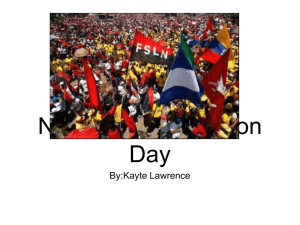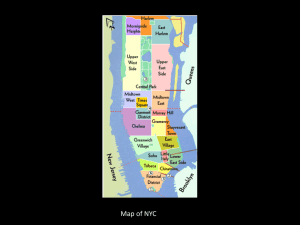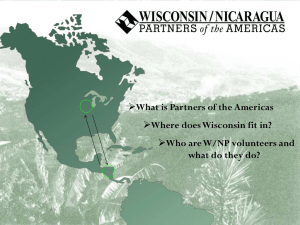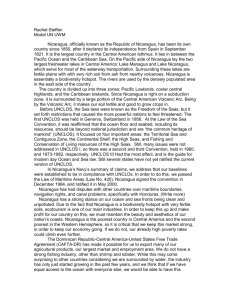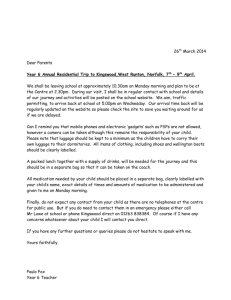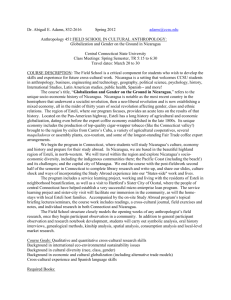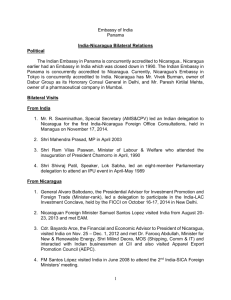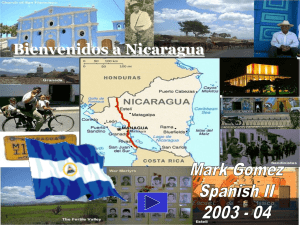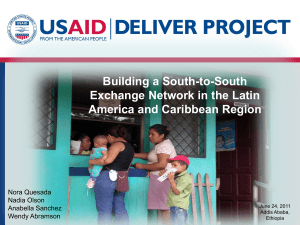Nicaragua Trip Guide
advertisement
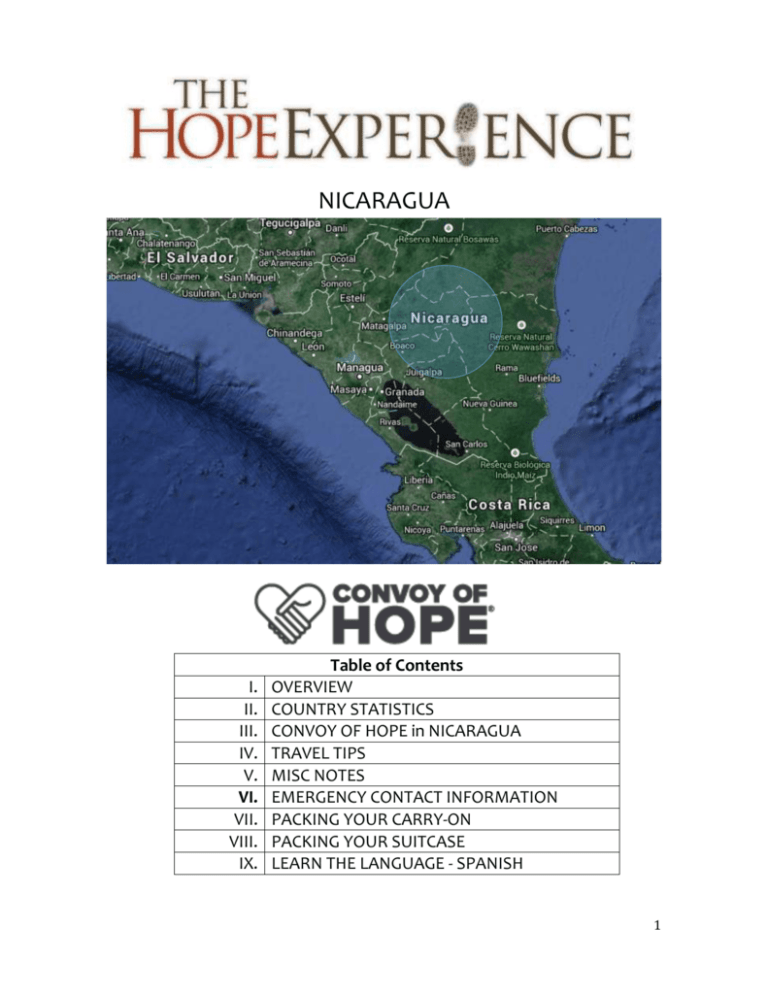
NICARAGUA I. II. III. IV. V. VI. VII. VIII. IX. Table of Contents OVERVIEW COUNTRY STATISTICS CONVOY OF HOPE in NICARAGUA TRAVEL TIPS MISC NOTES EMERGENCY CONTACT INFORMATION PACKING YOUR CARRY-ON PACKING YOUR SUITCASE LEARN THE LANGUAGE - SPANISH 1 I. OVERVIEW Despite being one of the poorest countries in Latin America, Nicaragua has increased its access to potable water and sanitation and has improved its life expectancy, infant and child mortality, and immunization rates. Income distribution, however, is very uneven, and the poor, the farmers, and the indigenous people continue to have less access to healthcare services. Nicaragua’s high birth rate among adolescents perpetuates a cycle of poverty and low educational attainment. Nicaragua is considered a safe country; it has the second lowest rate of car theft and the fourth lowest rate of kidnappings and robberies. Also, it shows the sixth lowest rate of homicides in Latin America, according to Latinvex. Last July, Forbes magazine highlighted that economic growth will likely make Nicaragua one of the main players in the region in the coming decade. II. COUNTRY STATISTICS 1 Population: 6,100,000 (est 2014)1 Under 14 years old: 31.7% (male 913,905/female 879,818) Second poorest country in Latin America 45% of population living below $1 a day 27.2% of the population 0-9 years old suffers from chronic malnutrition Urban Poverty: 30.2% Rural Poverty: 67.8% Urban population: 55.9 % School enrollment rate: 92%2 Primary school completion: 47.9% Classrooms in poor conditions: 52% Schools with drinking water: 48.50% http://www.pronicaragua.org/es/descubre-nicaragua/poblacion 2 http://www.un.org/en/development/desa/policy/capacity/country_documents/nicaragua_determinantes.pdf pag 63 2 Children under 5 suffering from chronic malnutrition: 20% Children 6-9 years old suffering from chronic malnutrition: 27.2% 110 out of 1,000 female adolescents (aged 15-19) are mothers 34% of those in extreme poverty are female-headed households 3 III. CONVOY OF HOPE IN NICARAGUA Convoy of Hope began working in Nicaragua in 1998, after Hurricane Mitch devastated the country. While COH continued to aid during the aftermath of storms and droughts in the country, it began its work with Children’s Feeding in 2006. Following success with feeding programs in communities, COH expanded into Women’s Empowerment and Agriculture in 2014. Convoy of Hope 2014 Program Centers in Nicaragua Children’s Feeding We are currently (as of July 1, 2014) feeding 6,178 children per day through 24 public schools, two private schools, three community centers and four ministries. By providing nutritious food full of micronutrients, we supplement the basic school lunch provided by the Ministry of Education at the public schools. The food provided by Convoy of Hope has approximately 30% of the daily nutritional requirements. We train mothers in food preparation and handling as well as proper hygiene. We teach students hygiene and 4 hand washing, proper use of water, tooth brushing, and the importance of a daily bath. We support teachers in educating for a balanced nutrition. Mother’s Clubs In June 2014, two Mother’s Clubs began in Program Centers where we have ongoing Children’s Feeding programs. The “Women’s Club for Action” in the neighborhood named Jonathan Gonzalez, in the city of Managua, has 14 mothers whose children go to the República de Canadá School. The “Women in Blessing” Club, is located in the municipality of Ciudad Sandino, specifically in the neighborhoods Canaán and Cristiana Socialista Solidaria, and has 15 mothers whose children attend the Bruno Martínez School. Both locations also form part of our feeding program. Mother’s Clubs are a great way for our local staff and volunteers to engage with mothers in a more in-depth way, with the objectives of improving women’s and children’s health; increasing knowledge about nutrition, sanitation, and hygiene; building self-esteem; teaching literacy and numeracy; and providing skills-based training to help the women earn income for their families. Agricultural Program Beginning in June 2014, we are planting and growing six gardens in schools and two community gardens through the Mothers’ Clubs. This involves 854 students, 30 parents of 53 households and 27 teachers. We encourage involvement of school community in garden activities. Students are trained in agricultural techniques and also taught about relating garden activities to food security. Community Outreach 5 In September 2014, we will have our second outreach event in Nicaragua called "Celebrating the Family and Community." It will be held in the Managua neighborhood Jonathan Gonzalez, where our Children’s Feeding program is active in the local school. The purpose of the event is to position COH as a Christian community development organization, building relationships between local churches, community organizations, and government. Families will have access to free health care services, a hot meal, children's games, guidance for employment, spiritual counseling and help, legal advice, and there will also be recreational activities for all who attend. Disaster Services In April 2014, an earthquake affected the municipalities of Managua, Mateare, Ciudad Sandino, and Nagarote. COH was already working in communities in all locations with the exception of Nagarote. We provided 6,000 food packages, 111 kitchen kits, 111 school packages. There were 2,000 beneficiary families, with aid in the amount of US$ 320,731. Fast Facts (2013 Stats) Children’s Feeding Participants: 6,178 Community Outreaches: 1 Families Served in Community Outreach: 800 Disaster Responses: 2 COH Staff: 5 6 IV. TRAVEL TIPS Travel Meds: Please consult your health care provider for appropriate travel medications and required vaccinations. According to the CDC, there is a low risk of malaria transmission in Managua, where we will be spending all of our time. If you are overly concerned, you may opt to take the anti-malaria pills or wear long sleeves and pants to prevent mosquito bites. Additionally, insect repellent with 35% DEET for skin and Permethrin for clothing is also effective. Departure: Team members will fly to Miami and overnight there on 10/7. Then our group will fly together from Miami to Managua the next morning. Please plan to connect with the team at the hotel. I will send you a list of those you will be traveling with a week before your departure. Luggage: For ease of travel and to eliminate the possibility of lost luggage, we recommend carry-on luggage only. The airlines will allow 2 carry-ons which fit in the overhead compartment or under your seat. If you must check luggage, it needs to be 50lbs or less. Passport: Please make sure you have your current passport along with your immunization record, available when applying for your visa. Please bring color copies of your passport with you. 1 for your carry-on, 1 for your checked luggage, and 1 for each hotel you will be staying in. Visa: A Visa is NOT required for entry into Nicaragua. Dress: The weather will be very hot! Please dress in lightweight clothing. Casual attire is fine. Short sleeve shirts or polos, and jeans or lightweight long pants are recommended. No shorts please. This will help prevent bug bites. A hat, a light jacket because the evenings can be chilly, and 7 comfortable closed toe walking shoes are imperative. The sun is very strong, so sunscreen is also very important. V. MISC NOTES Nicaragua is 2 hours behind EST We do not recommend carrying large amounts of cash. Although we will be staying in safe accommodations and Internet is available in the hotel, we do not recommend bringing laptops or other expensive equipment. If you would like to bring money to purchase souvenirs, you will be able to exchange your cash, not traveler’s checks, for local currency in Nicaragua. While we will be eating three meals each day, you may want to bring some snacks or protein bars. Label your bag with your name and destination address Label each bag inside with your name and home address Carry all cash, valuables, and medications with you on board 8 VI. EMERGENCY CONTACT INFORMATION Family Emergencies Please contact Sabra Smith at 417-851-4406 who will be able to reach us while in Nicaragua. They can also email me – kpage@convoyofhope.org Flight Emergencies Please contact Leah Mills. Her number between 8AM – 5PM Central time is 417-851-4439. After hours she may be reached on her cell phone 417.230.1393 (emergencies only please) Contact Information Please provide your loved ones with our contact information: Miami: Hotel: Courtyard Miami Airport South 1201 NW Le Jeune Rd Miami, FL 33126 Phone: 305-642-8200 Nicaragua: Hotel: Barcelo Managua Enitel Villa Fontana, 1500 mts al Sur Phone: +505 2280 98 10 Fax: +505 2280 98 15 Email: managua@barcelo.com 9 Primary Contact: Name: Andrea Frey-Metzger - Latin America Field Operations Director Mobile Phone: (417) 343-6308 Office Phone: (417) 851-4473 Email: afrey@convoyofhope.org Secondary Contact: Name: Pablo Gomez Email: pgomez@convoyofhope.org 10 VII. PACKING YOUR CARRY-ON Your carry-on bag can be a real lifesaver, especially if your luggage gets lost. Here is a sample list of items you might want to pack in your carry-on: Passport Color copies of Passport International Certificate of Vaccination Airline ticket and travel documents Change of clothes – essential in the event your checked luggage is lost or delayed Itinerary Pen and Pencil Address book, journal or small pad of paper Camera, batteries, chargers IPod, MP3 player Laptop if desired, but not recommended Money belt or pouch Sunglasses Anti-bacterial hand sanitizer Prescriptions Toiletries – include items in your carry-on that could not be replaced at our destination. Other items can be sealed in a larger zip-loc bag and placed in your suitcase Carry-on bag Liquids: 3.4 ounce (100ml) bottle or less (by volume); 1 quartsized, clear, plastic, zip-top bag; 1 bag per passenger placed in screening bin. One-quart bag per person limits the total liquid volume each traveler can bring. Consolidate bottles into one bag and X-ray separately to speed screening. 11 VIII. PACKING YOUR SUITCASE During our visit you can expect average high temperatures of 80-90 degrees during the day and average lows around 70 degrees at night. Dress: The weather will be very hot and humid! Please dress in lightweight clothing. Casual attire is fine. Short sleeve shirts or polos, and jeans or lightweight long pants are recommended. No shorts please. This will help prevent bug bites. A hat, a light jacket because the evenings can be chilly, and comfortable closed toe walking shoes are also imperative. The sun is very strong, so sunscreen is also very important. Some additional items you may want to bring include: First aid kit – band aids Moisturizer Sunscreen Lip Balm with sunscreen Insect repellent containing DEET Travel alarm clock Daypack Snacks (protein bars, nuts, etc.) Not necessary: Water – We will provide plenty of bottled water Valuable items – Please do not bring any item of value such as expensive jewelry 12 IX. LEARN THE LANGUAGE: SPANISH English Spanish Pronunciation Good morning. Buenos días. booEHN-os DEE-as Good afternoon. Buenas tardes. booEHN-as TAR-dehs Good evening. (greeting) Buenas noches. booEHN-as NO-chehs Hello, my name is Hola, me llamo OH-la meh YA-mo Wahn What is your name? ¿Cómo se llama? KOH-moh seh YA-mah How are you? ¿Cómo está? KOH-moh ehs-TA I am fine. Estoy bien. ehs-TOY bee-EHN Nice to meet you. Mucho gusto. MOO-choh GOOS-toh Goodbye. Adiós. ah-dee-OHS See you later. Hasta luego. AHS-ta looEH-go Where is the restroom? ¿Dónde está el baño? DOHN-deh ehs-TA el BAH-neeo Excuse me. Con permiso. OR Perdóname kohn pehr-MEE-soh OR pehr-DOHnah-meh Please. Por favor. pohr fah-VOR Thank you. Gracías. gra-SEE-ahs I'm sorry. Lo siento. low see-EHN-to Bless you. Salud. sah-LOOD You are welcome (it was nothing). De nada. deh NA-da How much does it cost? ¿Cuánto cuesta? kooAN-to KWEHS-ta How many are there? ¿Cuántos hay? kooAN-tohs eye There are many. Hay muchos. eye MOO-chohs Do you want to buy this? ¿Quiere comprarlo usted? kee-EHR-eh kohm-PRAR-loh oosTEHD What time is it? ¿Qué hora es? keh OR-ah ehs Yes. Sí. see 13 No. No. no I do not understand. Yo no comprendo. yoh no kom-PREN-doh Would you speak slower, Por favor, habla mas please. despacio. pohr fah-VOR, AH-blah mahs dehsPAHS-ee-oh Who? ¿Quièn? kee-EHN Why? ¿Por què? pohr keh 14
